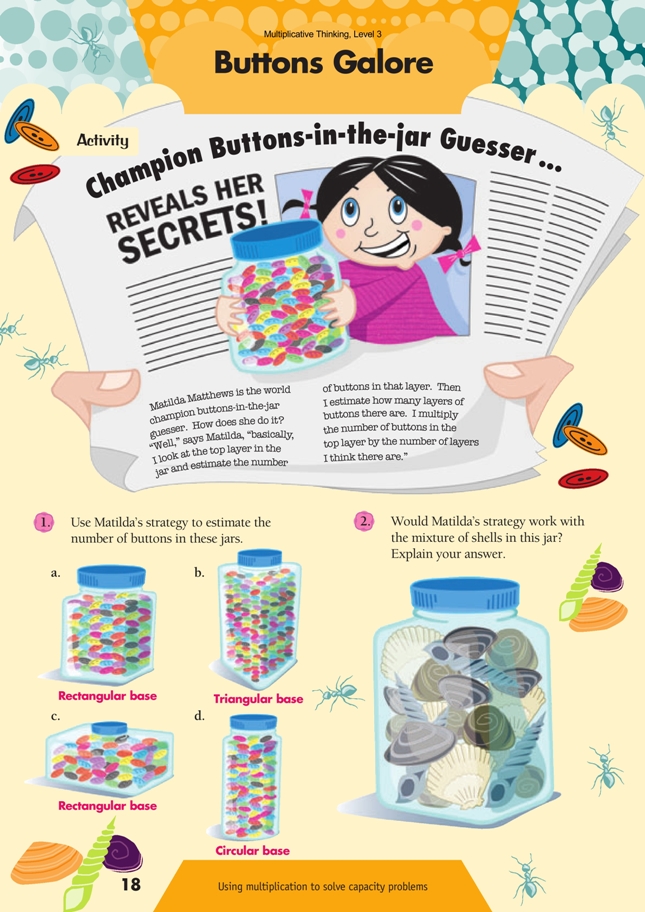This is a level 3 number activity from the Figure It Out series. It relates to Stage 6 of the Number Framework.
A PDF of the student activity is included.
Click on the image to enlarge it. Click again to close. Download PDF (706 KB)
estimte then multiply to solve problems
Number Framework Links
Use this activity to help students consolidate and apply advanced multiplicative part–whole strategies (stage 7) in the domain of multiplication and division.
This activity gives students opportunities to use a range of multiplicative strategies when finding the capacity (volume) of prisms, in this case using non-standard units.
An important concept introduced in this activity is that to find the capacity of a prism, you can measure what will fit in one layer and then multiply this by the number of layers.
Although the word “prism” is not used in the activity, this is a good opportunity to introduce the term. This may be the first time that many of your students have met the word prism, at least in a mathematical context. If this is the case, discuss its meaning with them. Ask Apart from being full of buttons or shells, what do all the (5) containers pictured in questions 1 and 2 have in common?
(They all have completely regular cross sections. For example, if you “sliced” container 1c anywhere parallel to the base, you would reveal a triangle identical to the ones that form its top and bottom. It is this quality that makes the containers prisms.) If the students have trouble seeing where the question is leading, introduce some containers that are not prisms (for example, bottles that are spherical or tapering at the top) and ask how these containers are different from the ones pictured.
There are lots of opportunities in this activity to discuss the merits of knowing a range of different multiplicative strategies. See the notes for Bean Counters (page 21) for reasons.
Before the students start the activity, you could remind them of the multiplicative strategies that they already know. Ask How many different ways can you solve 5 x 28 = ? Expect responses such as:
• doubling and halving: 5 x 28 = 10 x 14 = 140
• using a tidy number and compensating: 5 x 28 = (5 x 30) – (5 x 2) = 150 – 10 = 140
• using place value partitioning: 5 x 28 = (5 x 20) + (5 x 8) = 100 + 40 = 140.
Throughout the activity, ask questions such as:
• Before you start working out the problem, look at the numbers and decide which strategy is likely to be most efficient for this particular problem. Could you explain why to a classmate?
• Share your solution path with the group. Did someone else use a more efficient method? What is there about the problem that suggested the use of this strategy?
Extension investigation
How could you use Matilda’s method to measure the volume of a square or rectangular prism in square centimetres? Measure a box and explain what you did.
Answers to Activity
1. Answers will vary (you may count different numbers of buttons in each layer than other classmates).
Possible answers include:
a. About 100 buttons. (5 x 2 x 10)
b. About 300 buttons. (The bottle shape is triangular, with about 5 or 6 buttons on each of the front two sides. If this was a rectangle, this would be about 5 x 6 = 30 buttons. A triangle is half a rectangle, so 30 ÷ 2 = 15 for the top layer. There are about 20 layers, so 20 x 15 = 10 x 30 = 300.)
c. About 120 buttons. (There are about 6 x 4 x 5 buttons. 6 x 4 = 24. 24 x 5 = 12 x 10 = 120)
d. About 252 buttons. (There are about 8 buttons showing on the top layer, with probably 4 hidden at the back of the circle, and 21 layers.
12 x 21 = 10 x 21 + 2 x 21 = 210 + 42 = 252)
2. Yes, as long as the shells of different shapes and sizes are evenly mixed throughout the jar.
